May 28, 2004
FBI Abducts Artist, Seizes Art
Tragic and alarming news from my old acquaintances Steve & Hope Kurtz (we were at CMU at the same time): Hope died in her sleep & Steve called 911. When the cops showed up they mistook his art supplies for a bioterrorism lab and all hell broke loose. Full story and legal defense fund.May 26, 2004
performing at digital be-in
 I got a last-minute call to perform live video for the
Digital Be-In.
I'll be in the Trance Cube from about 11pm on,
playing with Axis Mundi,
and also providing material for Dianarosa in the main room.
I got a last-minute call to perform live video for the
Digital Be-In.
I'll be in the Trance Cube from about 11pm on,
playing with Axis Mundi,
and also providing material for Dianarosa in the main room.
May 22, 2004
props to josh goldberg
 I would like to publicly thank Josh Goldberg
for setting me up with some gigs in NYC and generally introducing me to the
scene. My first encounter with Josh was indirect. At Camp Disorient,
Burningman 2002 I was blown away
by the abstract swirly video feedback projected all over the dome.
Later I found out it was Josh on Dervish, his open source plug-in and patch
for Max/MSP. Turns out Josh is every bit as nice in person as through his art work.
I would like to publicly thank Josh Goldberg
for setting me up with some gigs in NYC and generally introducing me to the
scene. My first encounter with Josh was indirect. At Camp Disorient,
Burningman 2002 I was blown away
by the abstract swirly video feedback projected all over the dome.
Later I found out it was Josh on Dervish, his open source plug-in and patch
for Max/MSP. Turns out Josh is every bit as nice in person as through his art work.
shrek2
 Shrek2 is a funny and beautiful movie. I'm proud
to be in the credits. Thank you to all my friends
at PDI/DreamWorks.
Shrek2 is a funny and beautiful movie. I'm proud
to be in the credits. Thank you to all my friends
at PDI/DreamWorks.
Whitebox VIP pictures
Three photo galleries from Drum Machine Whitebox VIP XII performance: Lisa Fox, Bernie DeChant and Dennis Molina.

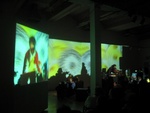
May 20, 2004
two future engagements
I don't have full details for these yet but I have two lectures in the pipe: Thursday June 3rd at siggraph silicon valley on the apple campus, and Friday June 18th at FutureSalon.May 18, 2004
ascension this thursday
 Ascension, the annual sflnc benefit is this thursday at 1015.
Everyone from Lorin to
Kid Beyond, Michael Christian to
Shakatura.
My still images and video loops will be projected in the basement,
and I'll be performing live in the main room with Hybrid and the Yard Dogs Road Show.
Ascension, the annual sflnc benefit is this thursday at 1015.
Everyone from Lorin to
Kid Beyond, Michael Christian to
Shakatura.
My still images and video loops will be projected in the basement,
and I'll be performing live in the main room with Hybrid and the Yard Dogs Road Show.
May 17, 2004
NewFangle
I was pleased to discover that my friend James Buckhouse is also in the show. James has done some really creative and well-executed pieces, and also helped me out a lot by opening his rolodex for me. And many years ago included me in his exhibition Refresh - Art of the Screen Saver. Thanks James it will be an honor to stand in your company.
bird's eye
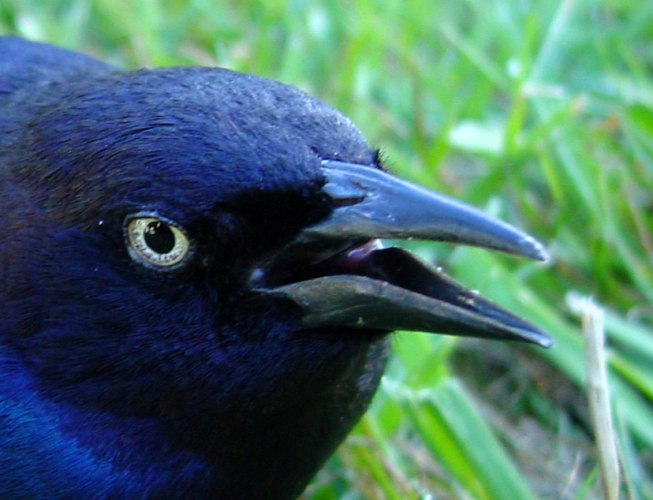
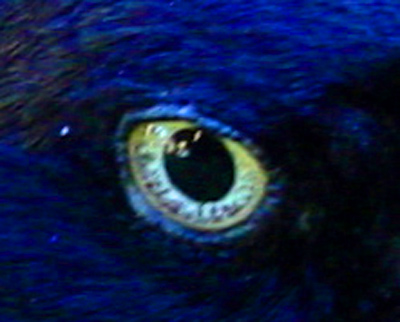 A starling or a blackbird? After Jessica's CIIS graduation ceremony this
poor critter flew into the hall and into one of the big picture windows
and fell to the floor stunned. It wasn't able to find a way out and
kept running into the windows so I captured it and let it go outside.
It just lay in the grass for quite some time and I don't know if it
recovered.
A starling or a blackbird? After Jessica's CIIS graduation ceremony this
poor critter flew into the hall and into one of the big picture windows
and fell to the floor stunned. It wasn't able to find a way out and
kept running into the windows so I captured it and let it go outside.
It just lay in the grass for quite some time and I don't know if it
recovered.
May 16, 2004
Images from Assacon
Luke Brown: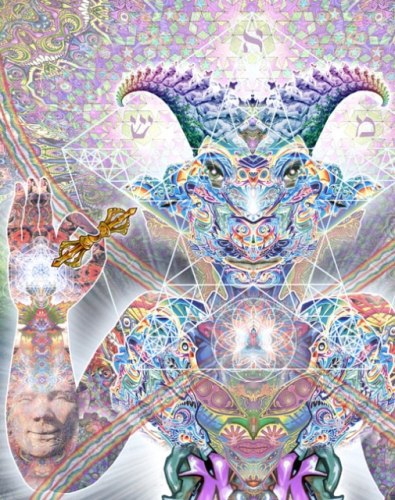
Carey Thompson:
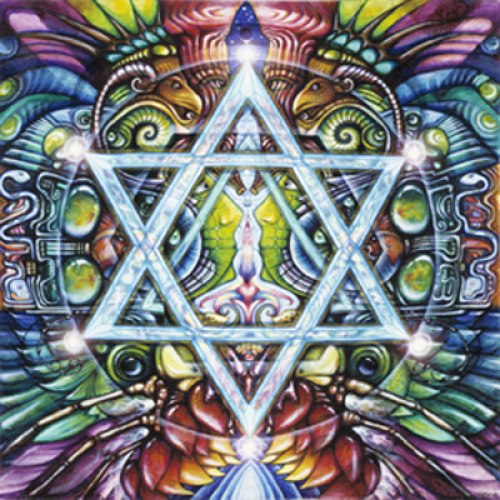
Xavier Panneton:
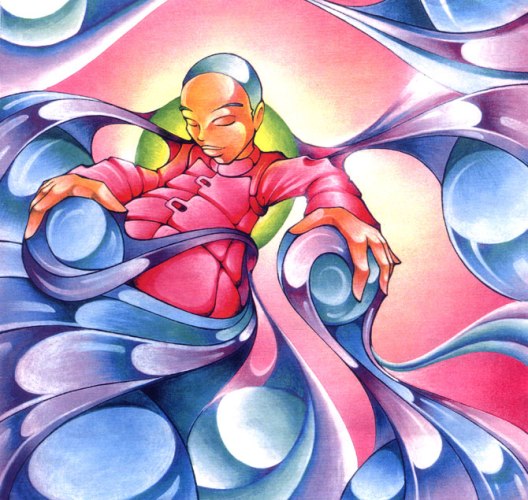
May 15, 2004
assacon
 This weekend I'm attending assacon, Altered States and the Spiritual Awakening, organized by and held at the False Profit warehouse.
I was at the sushi-reception last night and the artwork on the walls is beautiful, including a couple of pieces by Mark Henson.
This weekend I'm attending assacon, Altered States and the Spiritual Awakening, organized by and held at the False Profit warehouse.
I was at the sushi-reception last night and the artwork on the walls is beautiful, including a couple of pieces by Mark Henson.
May 11, 2004
NYC
May 10, 2004
word for the day: merkabah
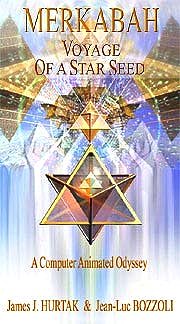 From the Qabalah, the Celestial Chariot that allows travel between
different planes of existence, especially to and between the 7 levels of heaven.
I came across it in the title of a video
shown to me by Alex Grey.
From the Qabalah, the Celestial Chariot that allows travel between
different planes of existence, especially to and between the 7 levels of heaven.
I came across it in the title of a video
shown to me by Alex Grey.
May 04, 2004
a positive review of SPOTWORKS
from Intelligent Agent Magazine, by Jeremy Turner. Here's the money quote:Spotworks is a VERY entertaining DVD collection and feast for your eyes and ears.And the full text for posterity:
Features: Dub Visuals, Electric Sheep and The Bomb -- each with a documentary explanation ("Sheepumentary" and "Inside The Bomb"). Audio by jhno, Spool, DJ Vordo and mbb. Special features: Looping tracks with solid backgrounds for use by any VJ. The imagery is all Open Source.
Web Link: http://electricsheep.org
Available from Microcinema.comNote: Not to be confused with Patrick Farley's Electric Sheep Comix
Being a closet bandwagon follower, I am going to make this DVD review completely dependent on other online resources. Therefore, the list of related links will appear first and not last. Call it either laziness or extra-contextual addiction, but I have come to the decision that summarizing the history of screensavers, visualizers and distributed computing applications would not only take up too much space in a small DVD review. There is much more detailed explanation of the aforementioned context online, and the following links should be required reading before delving into my review.
Just as you now need to buy the video game Enter The Matrix in order to complete the movie-dominant narrative of The Matrix Trilogy, you will also now need to browse these online links before being able to completely digest the context behind this Spotworks DVD review:
A Brief History of Screensavers
VJ FAQ
Playing Bass with Whale Tails: Exploring the Roles Of Visuals at Raves by Sean Healy (2001)
Distributed Computing links: http://www.aspenleaf.com/distributed/ http://www.scientopica.com/resources/
ARTIFICIALLIFE linksAnd now… an excerpted quote of praise from the Spotworks DVD homepage as a virtual cue card that will enable me to begin my convoluted review:
Now that the contextual basics behind screensavers, VJ/Rave Culture and A-Life applications have been consumed by the reader, I feel I can safely disagree with Erik Davis on his particular observation that this Spotworks DVD appears virtually spotless when it comes to kitsch. Aesthetically speaking, I would have to say that there is just as much trippydelic tackiness in Spotworks (both visually and aurally) as in any mainstream visualizer and screensaver application I have come across over the past decade. I should add that kitsch in general is not necessarily a bad thing, as far as I am concerned. There is nothing fundamentally wrong with appreciating kitsch and quite often, the aesthetic quality of kitsch is partially populist in nature because it appeals to the most basic and seductive of tastes (eyecandy and earcandy) and drives (the desire to be entertained by novelty).
In a way, this is a very difficult DVD to review as I found this VJ-friendly archive much more stimulating on a historical-nostalgic-aesthetic level than on the level of grooving with it as a direct embodiment of profound intellectual premises and theories from whence the applications here first came into being. To give Erik Davis credit where it is due, I believe that he is correct in that -- at least when it comes to Draves' Electric Sheepseries -- there is little in the way of fungal shapes and rave-friendly retro-fractal patterns (remember 1990?). On the contrary, it is amazing how the quality of the resolution (texture / timbre) and aesthetic articulation of each individual 'sheep' is fully dependent upon the quantity of active, registered Electric Sheep users online who are offering their computer bandwidth to benevolently act as virtually real-time render farms. When the user-base is high, the retro fractalization slowly becomes a highly detailed impressionist screenscape.
However, in Draves' earlierBomb period, one can say without much argument that fungoid fractals abound to please the frivolous whims of the Rave Community; but it still would be difficult to criticize Draves since he was producing this work in the early 90s where he would have been viewed as a pioneer and cutting-edge proactive proponent of the 90s technomantic zeitgeist.
This is one reason why it is hard to review this body of work today. It would be just as difficult to review Club Hits 97 or Dance Party 99 music compilations. The hype surrounding A-Life algorithms and participatory democracy that led to the creation and proliferation of artwork such asElectric Sheep seems to put the opus onto a much higher level of competition (it is survival of the fittest, after all) with (intellectually) interesting visualizer applications. If the entire Electric Sheep program were to be selected or rejected against the survival of other similar programs, how well would it fare (in the 1990s and today)?
Especially today, these programs are becoming exponentially taken for granted and phased out by Darwinian selection. Mass culture seems to be increasingly turning into a loyal disciple of Moore's Law where technology doubles every 18 months and aesthetic innovations become almost archaic only seconds after their unveiling. I am guessing that Draves' work -- when it was first unveiled to the public -- was already hailed as an 'Instant Classic.' In other words, visualizers with collaborative components and genetic algorithms for evolutionary selection have by now become almost ubiquitous.
In terms of the evolutionary process (i.e. online eugenics) that helped to determine the overall form of the 'Sheep,' I found it rather strange that the fittest entities, which managed to survive into the "Best of 2002" category, hardly seemed to resemble discrete entities but had much more in common with their landscape predecessors in the screensaver historical continuum. In a figure-ground relationship, the ground seemed to be much more popular than the entity-reinforcing figure. The evolution is focused on articulating the framing of the screen rather than the development of figural entities. In this case, the distributed user base seemed to prefer a 'truth to the medium' paradigm.
Clement Greenberg would be proud to know that the voting user base intuitively believed that any screensaver pretending to be anything other than merely a pleasurable screenscape for the eye, would not be true to its medium. These screenscapes are not the kind of Sheep to be dreamed up by androids; although they share a quasi-biological process with organic entities, I would consider the entities produced via the GOLEM project (see related links below) to be a much more reasonable example of entity-based A-Life software in action…and hey, GOLEM also doubles as a handy screensaver.
In conclusion, Draves' DVD archive seems to be more about the history of aesthetic VJ processes and tastes than the picturesque genealogy of distributed computing. Although I truly enjoyed watching all the demos and narration about the history behind the making of Draves' visual work, I cannot say how it would survive today among the seemingly endless variants of the A-Life screensaver genre that are becoming common fare. If I reviewed the DVD in 1999, my opinion might have been more with the times. I feel like a black sheep of the new media flock by reviewing the DVD through such a 'period-specific' lens, so I want to emphasize that all in all, is a VERY entertaining DVD collection and feast for your eyes and ears.Here are some more links which were not 'required reading' for the review but will help the reader even more:
GOLEM@ Home Project (Genetically Organized Lifelike Electro Mechanics)
The screensaver randomly creates a population of virtual robots on your system and then evolves them (the current rule for evolution is survival of the robots who can move the greatest distance over an infinite plane). Every week or so, a few of your robots will move to someone else's GOLEM screensaver and a few of someone else's robots will move to your screensaver (you can disable this feature if you're worried about security). These virtual robots contain design information that can be used to build actual working robots.
Note: entities can become sculptural using a 3D printer = much better discrete identity representation.
http://demo.cs.brandeis.edu/golem/ / http://demo.cs.brandeis.edu/golem/download.html / http://demo.cs.brandeis.edu/golem/next.html
Folderol, Scott Legrand: http://dsonline.computer.org/0101/features/fol0101_print.htm
Design and evolve robotic lifeforms via a screensaver. Based on representation of protein folding.
Muon1, Distributed Particle Accelerator: http://muon.mega-revi
extended trip & remote lounge deets
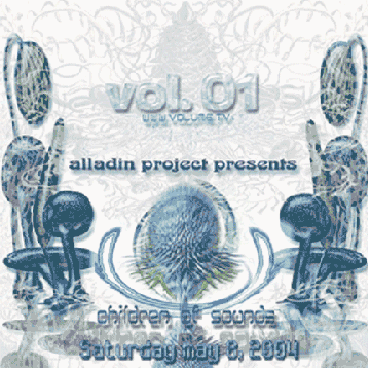 I've extended my trip to NYC for a couple of days to play a psy-trance party at Volume in Williamsburg on Saturday night. 5500 sq feet and 50k watts.
I've extended my trip to NYC for a couple of days to play a psy-trance party at Volume in Williamsburg on Saturday night. 5500 sq feet and 50k watts.
And for the Remote Lounge on Wednesday my set is 10:45-11:30.
Earlier on Wednesday I'm lecturing at 26 Greene St, Location One for Dorkbot under the direction of Douglas Repetto.
May 02, 2004
zloblog copying my photos
I have noticed traffic from the zloblog into my photo pages. I took a look and sure enough he had copied my pictures into his blog... without giving me credit or linking to me! So where was the traffic coming from? I looked into his archives and found more of my images, some of which did have links. I couldn't find an email address for whoever runs this so I left a comment asking for attribution.There are some other similar looking referrers that I can't get into: xpeople.org, ouderalleen.nl.